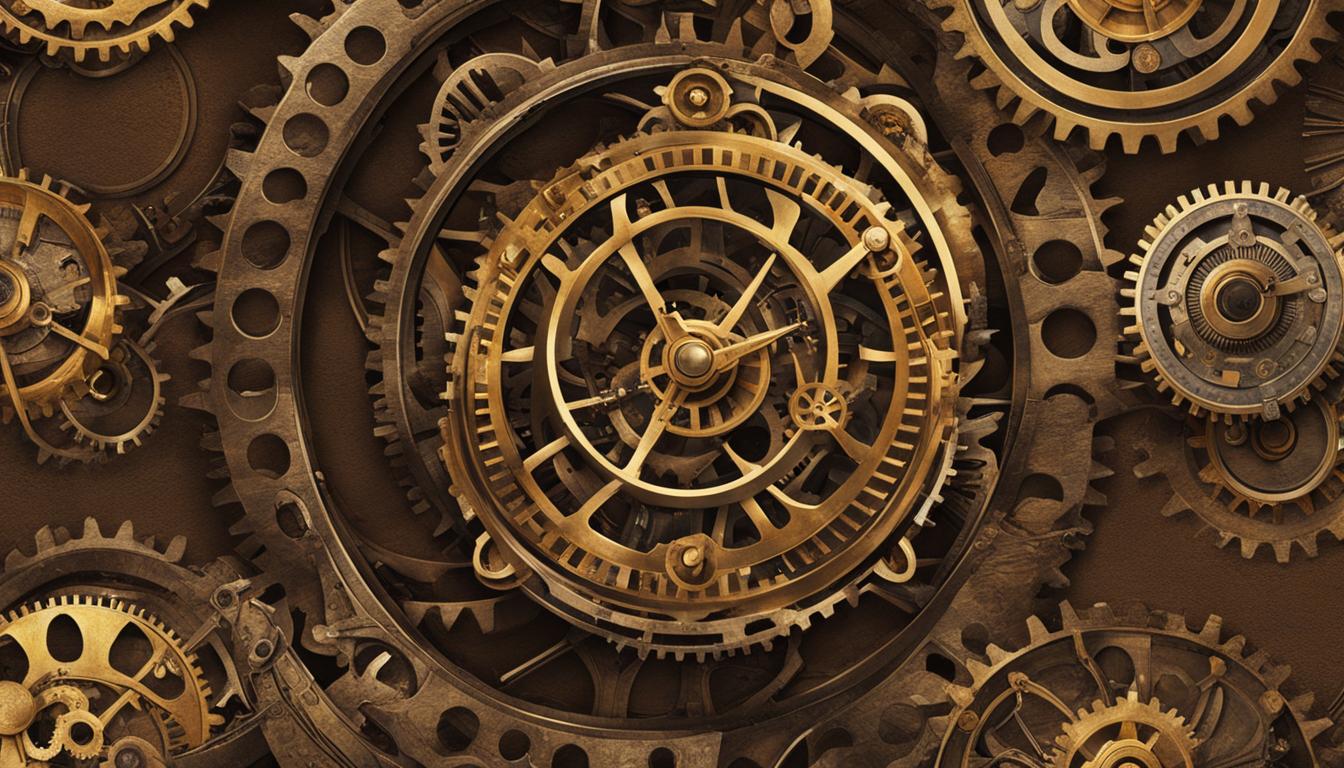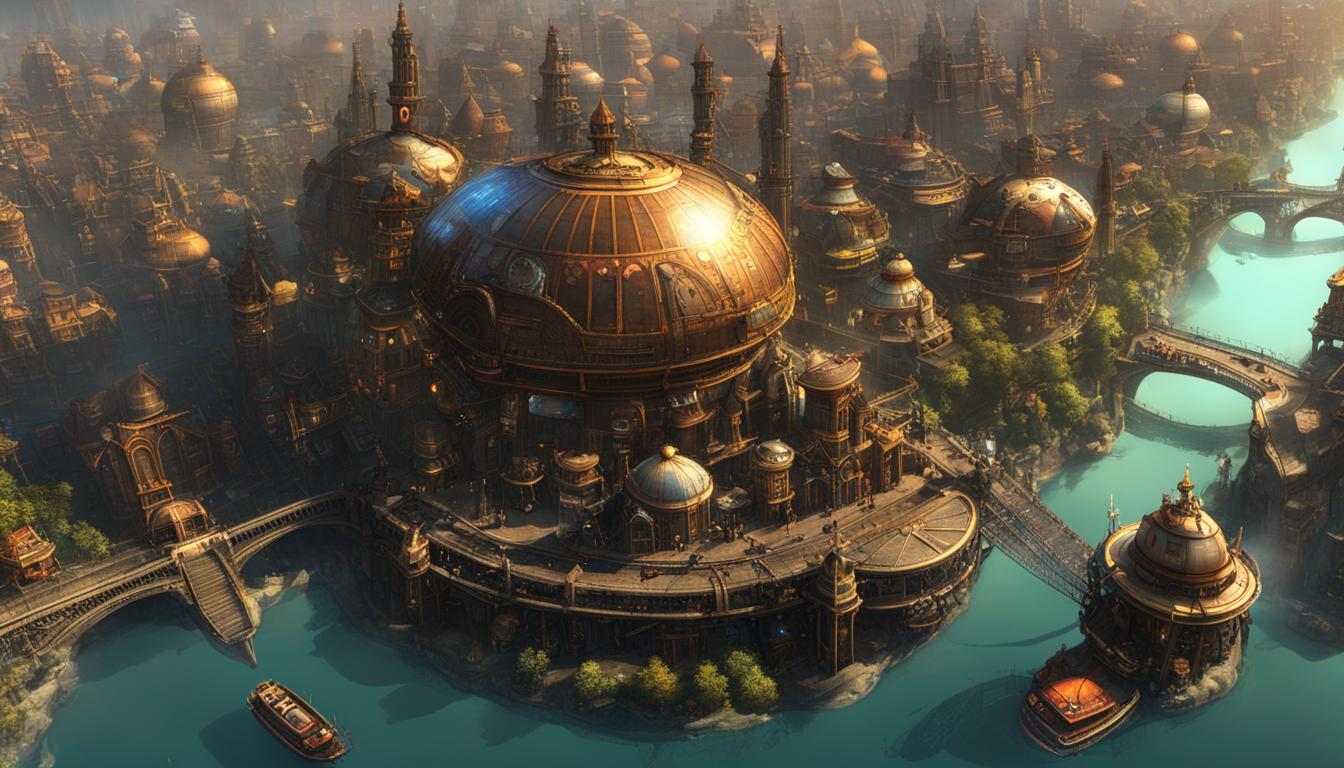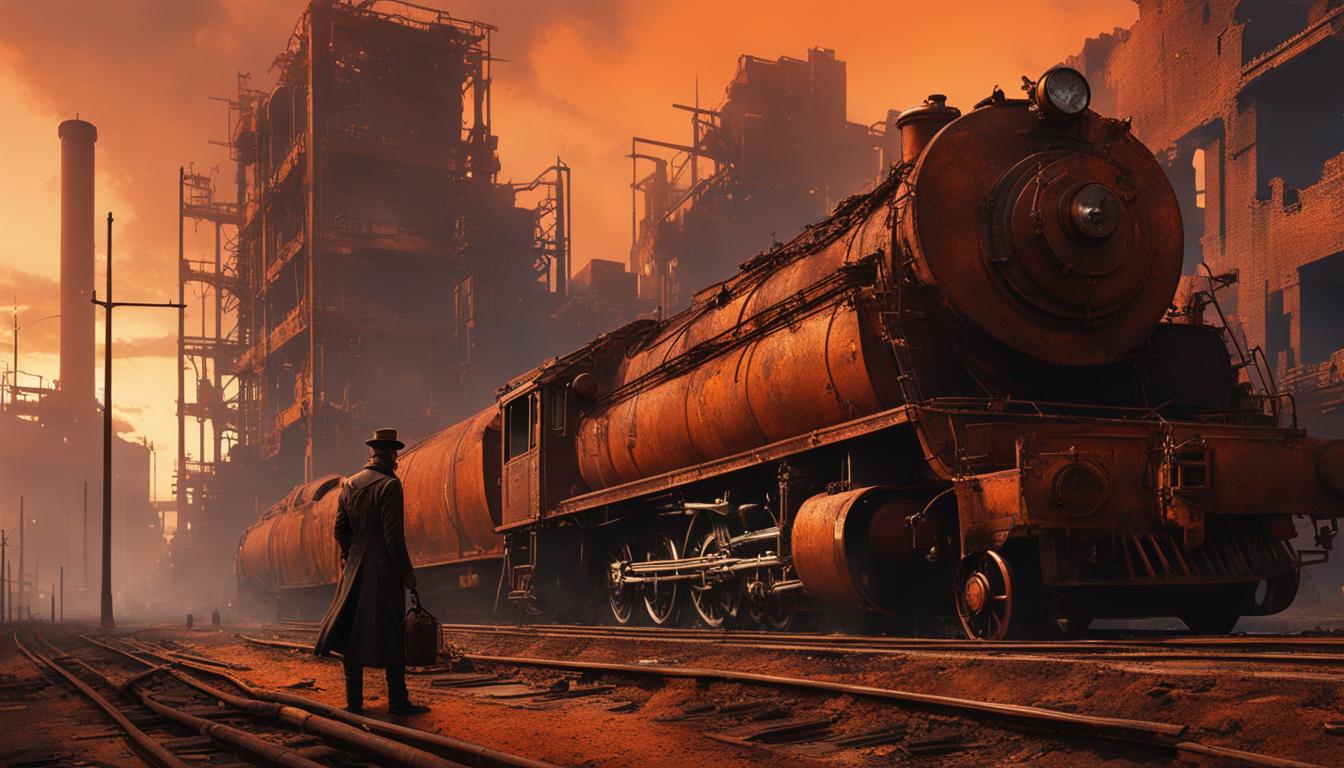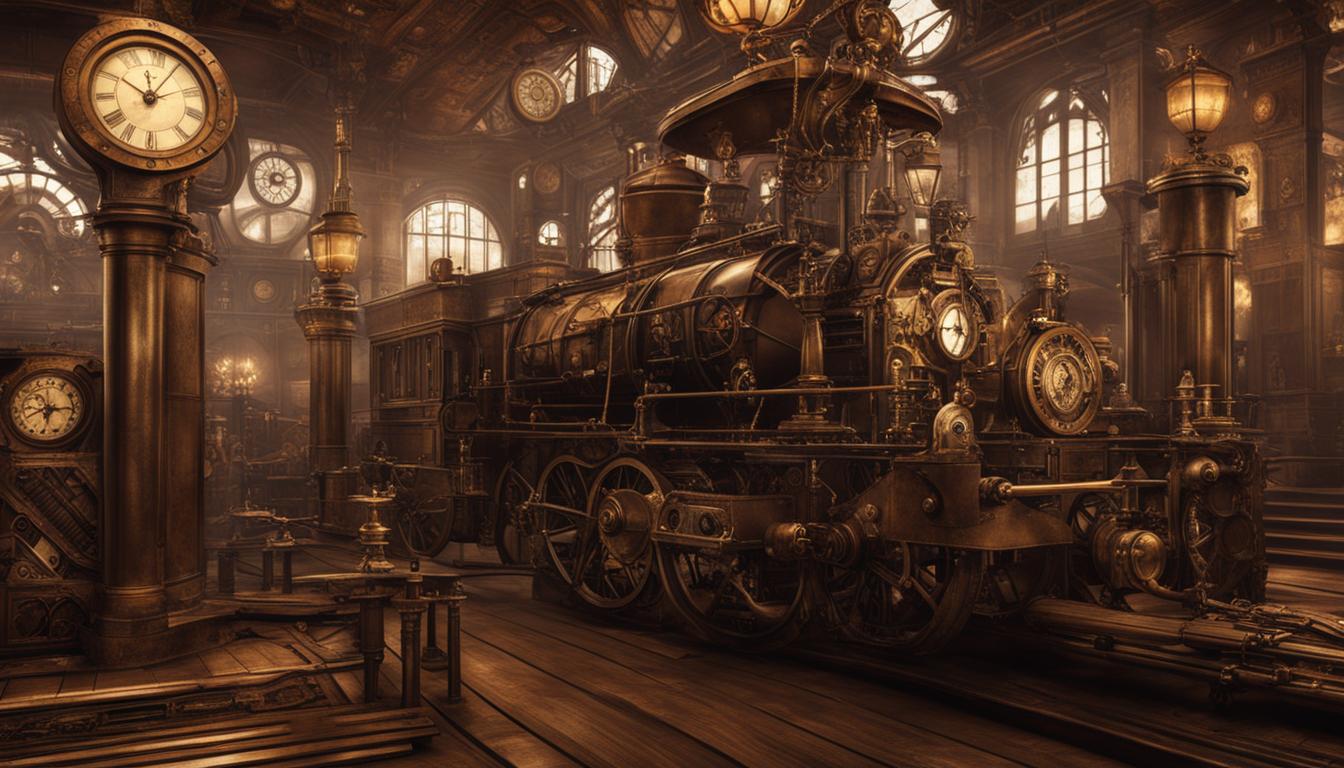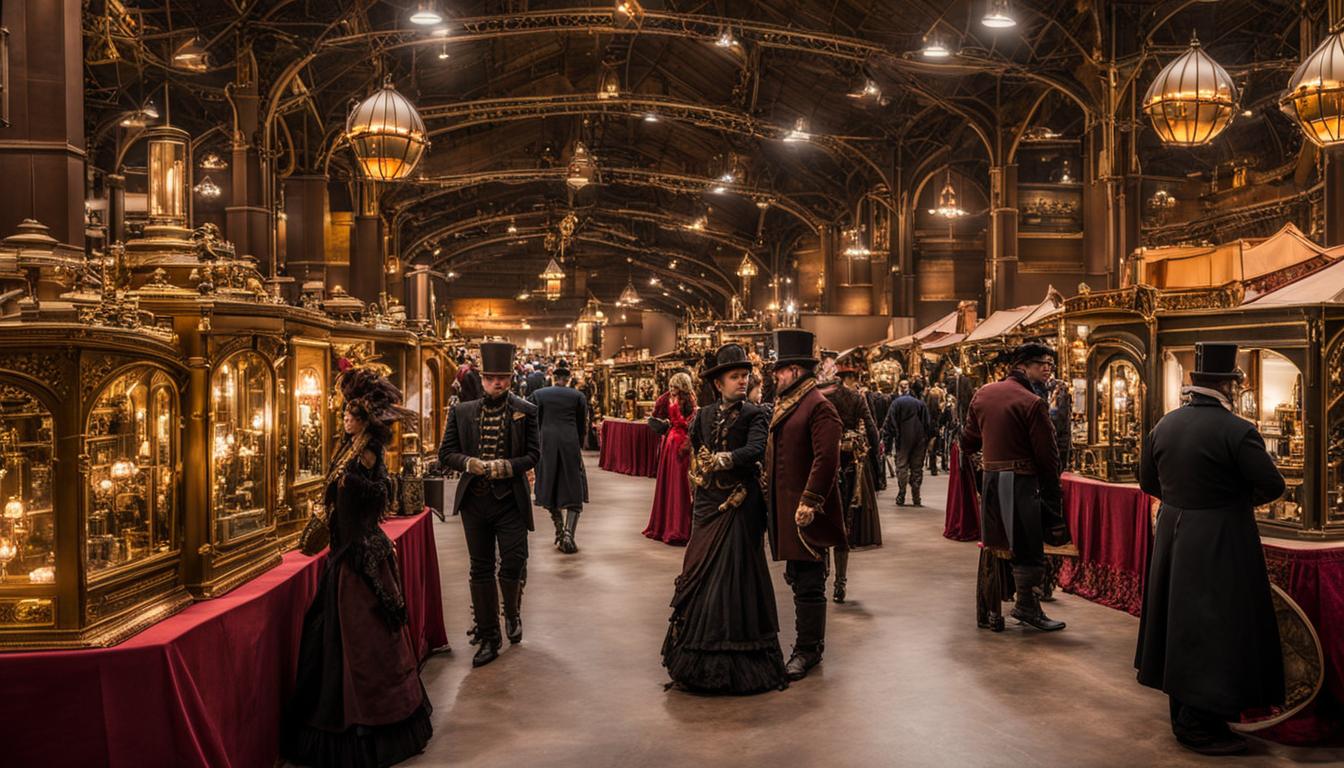Steampunk, a subgenre of science fiction, has taken the pop culture world by storm with its unique blend of retrofuturistic technology and Victorian aesthetics. From its humble origins to its significant cultural impact, steampunk has grown in popularity and captured the imaginations of audiences worldwide.
Steampunk transports us to an alternative history where steam power reigns supreme, often set in the Victorian era or the American “Wild West.” It combines anachronistic technologies and inventions with the charm and elegance of the 19th century. Over time, steampunk has expanded, incorporating elements from other genres and time periods, making it a truly unique and versatile genre.
One cannot underestimate the cultural impact of steampunk. It has influenced not only the realm of literature but also fashion, art, films, TV shows, and even video games. Its influence can be seen in the intricate designs of steampunk-inspired fashion and the immersive worlds of steampunk-themed video games. Steampunk has created a subculture of its own, with dedicated enthusiasts coming together to celebrate and embrace its charm and creativity.
Key Takeaways:
- The evolution of steampunk in pop culture showcases its growth and impact on various forms of media.
- Steampunk combines retrofuturistic technology and Victorian aesthetics, creating a unique and recognizable genre.
- Steampunk has influenced fashion, art, films, TV shows, and video games, leaving a lasting cultural impact.
- Steampunk continues to evolve, incorporating elements from different time periods and cultures, keeping its creative possibilities alive.
- The subgenre of steampunk has its roots in the 19th-century scientific romances and has expanded to become a prominent force in popular culture.
The Origins of Steampunk: Precursors and Influences
Steampunk as a genre has its roots in the 19th-century scientific romances of authors like Jules Verne, H.G. Wells, Mary Shelley, and Edward S. Ellis. These visionary writers explored futuristic ideas and technologies within the backdrop of a Victorian setting, laying the foundation for the steampunk genre we know today. Their imaginative tales of steam-powered machinery and fantastical inventions set the stage for the blending of science fiction and the Victorian era.
But the influences on steampunk extend beyond literature. The CBS television series “The Wild Wild West,” with its combination of Western and technology, became an early precursor to steampunk. The film “Brazil” also played a significant role in shaping the aesthetic and themes of the genre. In the realm of visual art, Remedios Varo’s paintings captured a sense of whimsy and anachronistic technology, contributing to the development of the steampunk aesthetic.
Steampunk has its roots in the literary works of authors like Jules Verne and H.G. Wells, as well as the visual art of Remedios Varo. These precursors laid the groundwork for the fusion of Victorian aesthetics and futuristic technology that define the steampunk genre.
The influences on steampunk are diverse, drawing from various mediums and sources of inspiration. From the writings of Victorian-era sci-fi authors to television shows, films, and visual art, each has contributed to the evolution of the genre. These precursors and influences have shaped steampunk into a rich and vibrant genre that continues to captivate audiences today.
Table: Influences on Steampunk Genre
| Literature | Television | Film | Visual Art |
|---|---|---|---|
| Jules Verne | The Wild Wild West | Brazil | Remedios Varo |
| H.G. Wells | – | – | – |
| Mary Shelley | – | – | – |
| Edward S. Ellis | – | – | – |
The Definition of Steampunk
Steampunk can be defined as a captivating fusion of Victorian-era science fiction and retrofuturistic aesthetics. It is a genre that draws inspiration from the industrial revolution, imagining a world where steam-powered technology dominates. Steampunk stories often take place in an alternate version of the Victorian era, where steam-powered machinery and inventions coexist with the elegance and fashion of the time.
The core of steampunk lies in its intricate and detailed aesthetics. The genre embraces a unique blend of industrial and elegant elements, showcasing a visual feast of clockwork machinery, brass gears, and vintage fashion. The steampunk fashion scene often features corsets, top hats, goggles, and gears as accessories, creating a distinct and recognizable style.
The intricate machinery and retrofuturistic appeal of steampunk have captured the imaginations of creators and enthusiasts alike, giving rise to a vibrant subculture and inspiring art, literature, and media.
While steampunk is rooted in the Victorian era, it is a genre that is not confined by strict boundaries. It has the flexibility to incorporate elements from other genres, time periods, and cultures, allowing for endless creative possibilities. This versatility has contributed to the genre’s enduring popularity and its ability to captivate audiences across different mediums.
Table: Steampunk Aesthetics
| Elements | Description |
|---|---|
| Industrial | Steampunk incorporates the raw machinery, gears, pipes, and steam-powered technology of the industrial revolution. |
| Elegant | Despite its industrial influences, steampunk also embraces the elegance and fashion of the Victorian era, with a focus on corsets, top hats, and vintage clothing. |
| Retrofuturistic | Steampunk envisions a futuristic world through a lens of the past, combining historical aesthetics with speculative technology. |
| Unique Gadgets | Steampunk is known for its imaginative gadgets and inventions, often powered by steam and incorporating clockwork mechanisms. |
Steampunk’s definition may vary depending on individual interpretations and the creative visions of artists and writers. However, at its core, steampunk remains a genre that celebrates the fusion of Victorian-era science fiction, retrofuturism, and captivating aesthetics.
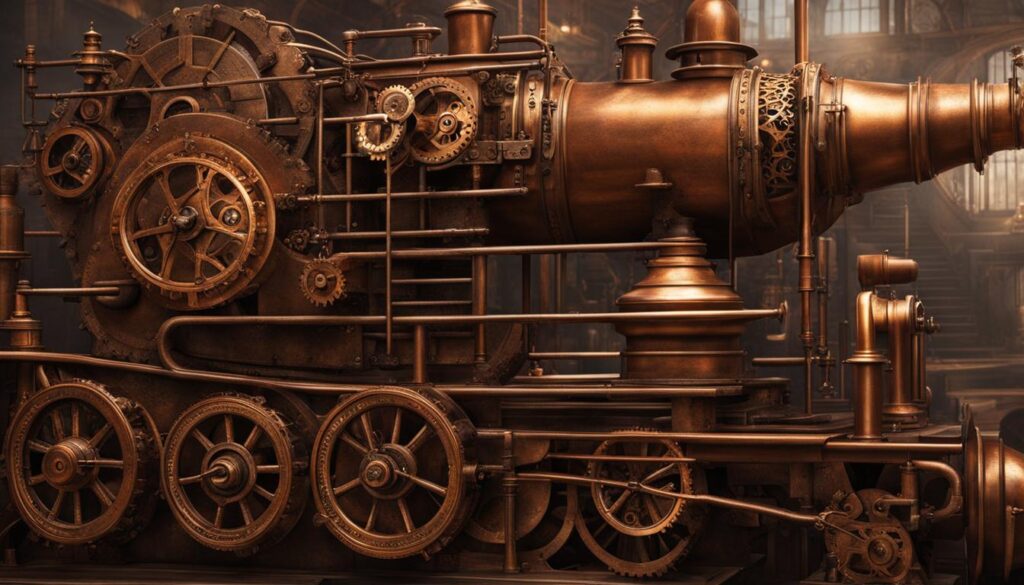
The Evolution of Steampunk in Literature and Media
Steampunk has undergone a remarkable evolution in various forms of media, ranging from literature to film, television, and even video games. This unique genre has captured the imagination of audiences worldwide with its blend of Victorian aesthetics and retrofuturistic technology.
In literature, steampunk has produced notable works that have become touchstones of the genre. One such example is “The Difference Engine” by William Gibson and Bruce Sterling, which explores a world where Charles Babbage’s analytical engine was successfully built, ushering in an era of steam-powered technology. Another prominent steampunk literary series is Philip Pullman’s “His Dark Materials” trilogy, which incorporates elements of steampunk within a rich and fantastical universe.
Steampunk also finds its place in the realm of film and television. Examples of steampunk in film include the beloved classic “Chitty Chitty Bang Bang,” which features an eccentric inventor and his fantastical inventions. Additionally, the anime films of Studio Ghibli, such as “Castle in the Sky” and “Howl’s Moving Castle,” showcase stunning visuals and imaginative storytelling intertwined with steampunk themes.
Video games have also embraced the steampunk aesthetic, offering players immersive experiences in alternative worlds filled with steam-powered contraptions and Victorian-inspired settings. The “BioShock” series, for example, combines elements of steampunk with dystopian themes to create a captivating and atmospheric gaming experience. “Legend of Zelda: Spirit Tracks” also incorporates steampunk elements, featuring a steam-powered train as a key gameplay mechanic.
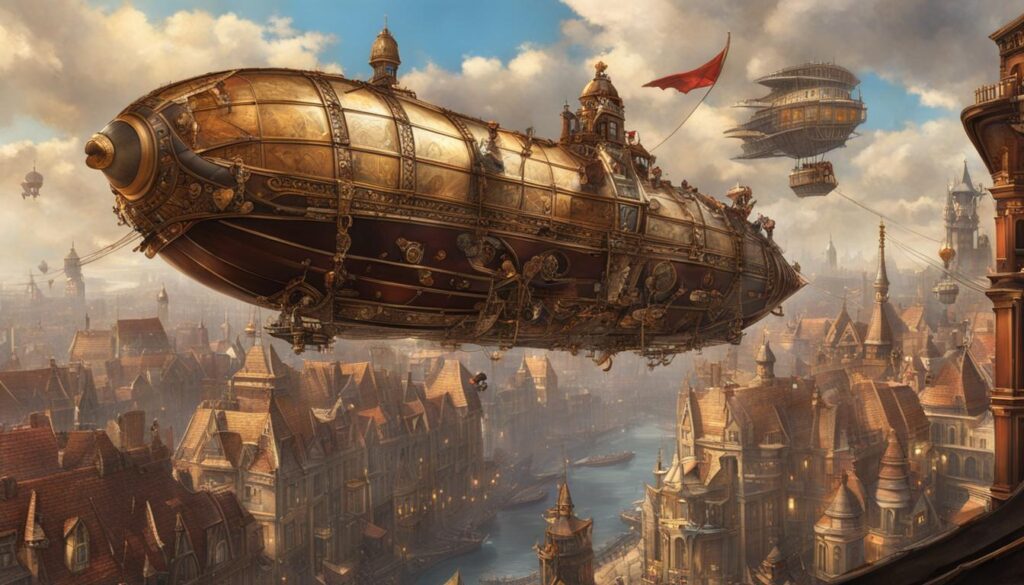
| Steampunk in Literature | Steampunk in Film and TV | Steampunk in Video Games |
|---|---|---|
| “The Difference Engine” by William Gibson and Bruce Sterling | “Chitty Chitty Bang Bang” | “BioShock” series |
| “His Dark Materials” trilogy by Philip Pullman | Anime films of Studio Ghibli (e.g., “Castle in the Sky”, “Howl’s Moving Castle”) | “Legend of Zelda: Spirit Tracks” |
Steampunk Aesthetics and Cultural Significance
Steampunk aesthetics have captured the imagination of enthusiasts around the world, inspiring a unique and visually captivating fashion trend. The blend of industrial and elegant elements creates a distinct look that sets steampunk apart from other genres. From corsets and waistcoats to top hats and goggles, steampunk fashion embraces the Victorian era while infusing it with a futuristic twist.
But steampunk is more than just a fashion statement—it has given rise to a vibrant subculture. Enthusiasts gather at conventions, known as “cons,” where they showcase their creative outfits, attend workshops, and immerse themselves in the steampunk world. These events have become a hub for artists, authors, and makers to connect and collaborate, fostering the growth of the steampunk community.
The cultural impact of steampunk extends beyond fashion and subculture. Its influence spans art, music, and design, leaving its mark on popular culture. Artists draw inspiration from the retrofuturistic world of steampunk, creating stunning paintings, sculptures, and installations that transport viewers to an alternate Victorian era. Musicians weave the steampunk aesthetic into their performances, combining vintage instruments with modern technology, resulting in unique soundscapes. Designers integrate steampunk elements into their products, combining functionality with the allure of a bygone era.
Table: Steampunk Fashion Accessories
| Accessories | Description |
|---|---|
| Goggles | Protective eyewear with a retro-futuristic design, often adorned with gears and metallic accents. |
| Top Hat | A classic Victorian hat that adds an air of elegance and sophistication to any steampunk ensemble. |
| Corset | A defining feature of steampunk fashion, corsets accentuate the waist and create an hourglass silhouette. |
| Waistcoat | A vest-like garment that adds a touch of formality to steampunk attire, often adorned with intricate patterns and metallic buttons. |
| Pocket Watch | An essential accessory for any steampunk aficionado, pocket watches evoke a sense of timelessness and nostalgia. |
“Steampunk is not just a style; it’s a way of life. It’s about embracing creativity, reinventing the past, and envisioning a future that never was.” – Anonymous
Steampunk continues to captivate audiences with its fascinating blend of the past and the future. Its aesthetics and cultural significance have made it a genre that resonates with people around the world, sparking their imagination and inspiring them to create their own steampunk adventures.
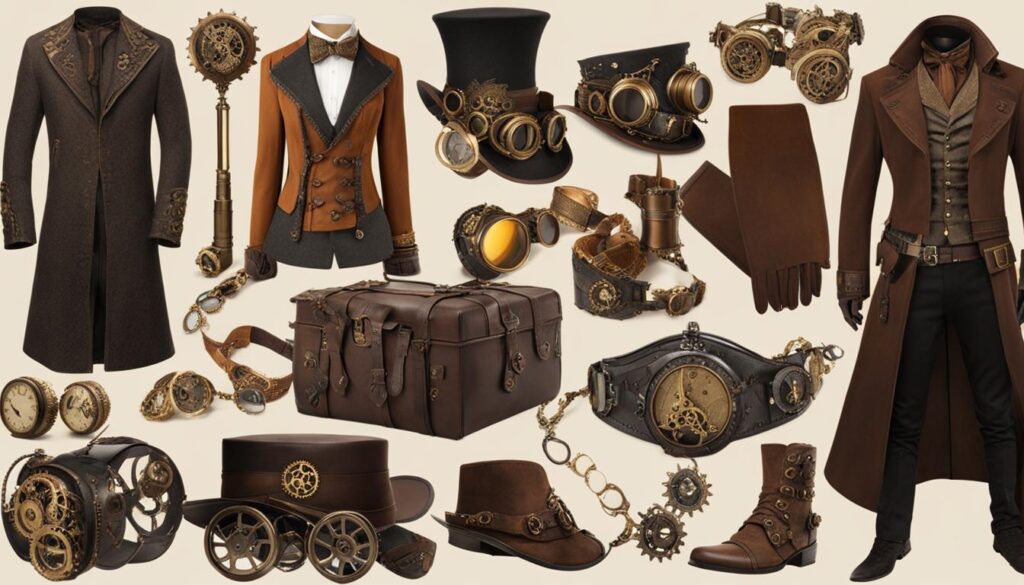
Japanese Steampunk and International Influence
Japanese steampunk has emerged as a captivating subgenre within the broader steampunk movement. Drawing inspiration from manga and anime, it brings a unique and visually stunning twist to the world of steampunk. With its distinct blend of retrofuturistic aesthetics and storytelling, Japanese steampunk has garnered international attention and influence.
Introduced to Japanese manga as early as the 1940s, steampunk themes found a receptive audience in the country known for its rich and imaginative storytelling. Influenced by European authors such as Jules Verne, Japanese manga creators embraced the steampunk aesthetic, weaving intricate narratives set in alternative historical worlds.
“Japanese steampunk has a certain charm that sets it apart. It seamlessly combines the fantastical elements of steampunk with the strong visual storytelling traditions of manga and anime,” explains renowned manga artist Hiroshi Mori. “It’s a fusion of worlds that captivates readers and viewers alike.”
One of the most prominent voices in Japanese steampunk is Hayao Miyazaki, the visionary animator behind Studio Ghibli. Miyazaki’s films, such as “Castle in the Sky,” “Howl’s Moving Castle,” and “The Wind Rises,” showcase the intricate attention to detail and whimsical narratives that have become hallmarks of Japanese steampunk.
International Steampunk Influence
The influence of Japanese steampunk has extended well beyond its borders, captivating fans around the world. Its distinct blend of East and West aesthetics, coupled with compelling storytelling, has left a lasting impact on global steampunk culture.
“Japanese steampunk has injected fresh energy into the genre,” says Dr. Emily Chen, a professor of cultural studies. “Its fusion of different cultural influences has sparked new ideas and creativity among steampunk enthusiasts worldwide.”
From steampunk conventions in Europe to cosplay events in the United States, Japanese steampunk has made its mark on the international stage. Its imaginative worlds and stunning visuals continue to inspire artists, writers, and filmmakers, pushing the boundaries of what steampunk can be.
Steampunk and Retrofuturism: A Fascinating Relationship
Steampunk and retrofuturism are two captivating concepts that often intertwine, offering a unique glimpse into imagined worlds where technology has developed differently. Steampunk, with its focus on the Victorian era and steam-powered technology, can be seen as a distinctive strand of retrofuturism. While they share similarities, each has its own aesthetic and storytelling style.
In steampunk, the Victorian era serves as the backdrop for fantastical stories that combine elements of science fiction with an unconventional edge. Retrofuturism, on the other hand, encompasses a broader range of time periods and technologies, spanning from the 19th century to the mid-20th century and beyond. It explores alternative visions of the future that were imagined in the past, often incorporating retro-inspired designs and futuristic concepts.
“Steampunk and retrofuturism invite us to reimagine history and envision what might have been. They create worlds that are both familiar and unfamiliar, blurring the boundaries between the past, present, and future.”
While steampunk and retrofuturism may seem distinct at first glance, they often complement and influence each other. The richly detailed Victorian aesthetics of steampunk have inspired retrofuturistic visions, while retrofuturism has provided steampunk with a broader range of technological possibilities and narrative ideas. As a result, these two concepts have become deeply intertwined, offering enthusiasts and creators endless possibilities for storytelling, design, and exploration.
Steampunk vs. Retrofuturism: A Comparative Overview
| Steampunk | Retrofuturism |
|---|---|
| Focuses on the Victorian era | Encompasses a broader range of time periods |
| Features steam-powered technology | Explores various technological concepts |
| Blends science fiction and unconventional elements | Blurs the boundaries between past, present, and future |
| Emphasizes elegant and industrial aesthetics | Incorporates retro-inspired designs |
Steampunk and retrofuturism continue to captivate audiences with their imaginative worlds and limitless storytelling possibilities. Whether it’s the intricate clockwork mechanisms of steampunk or the nostalgic visions of the future in retrofuturism, these genres offer a unique escape into alternative worlds where the past and future converge in fascinating ways.
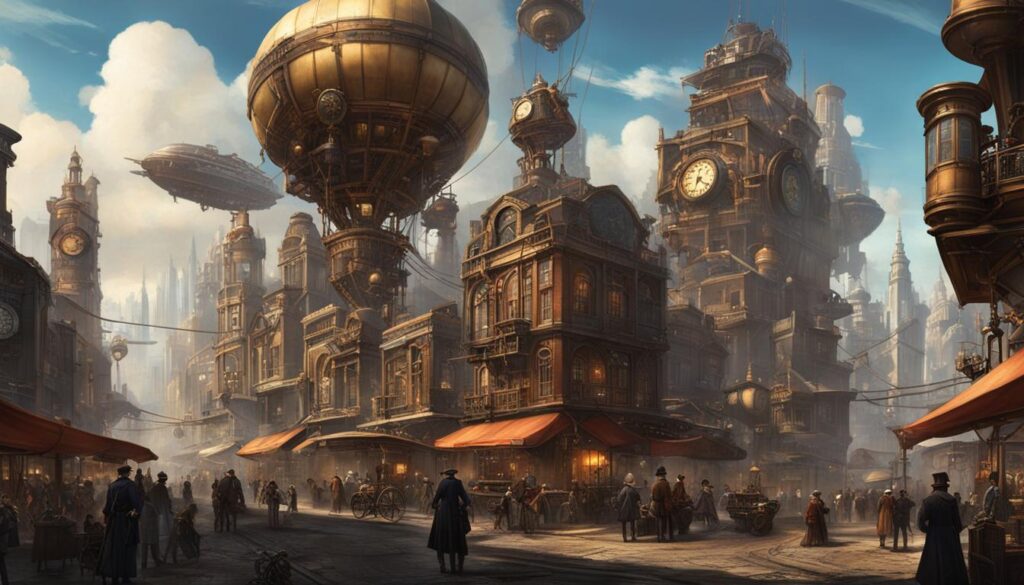
As the popularity of steampunk and retrofuturism grows, so does their influence on popular culture. From literature and film to fashion and design, these genres have left an indelible mark on various artistic mediums. They provide us with a delightful blend of nostalgia and speculation, inviting us to question what could have been while appreciating the wonders of the past and the possibilities of the future.
Conclusion
As the gears of time turn, steampunk has emerged from the depths of the Victorian era to claim its rightful place in pop culture. With its fusion of retrofuturistic technology and elegant aesthetics, steampunk has weaved its way into the hearts and minds of audiences worldwide. From literature to film, TV to video games, and even fashion, this genre has left an indelible mark on our collective imagination.
Steampunk’s evolution has not been limited to a fixed point in history. Instead, it has embraced the possibilities of time and space, incorporating elements from different eras and cultures. What started as the brainchild of visionary authors such as Jules Verne and H.G. Wells has now become a genre that continues to captivate with its imaginative stories and stunning visuals.
Steampunk’s cultural impact cannot be understated. It has inspired a subculture of enthusiasts who have transformed everyday objects into works of art, all in the name of steam-powered wonder. This genre has given rise to social events and gatherings, where individuals can indulge in their love for all things steampunk. Its influence extends beyond the realms of art and fashion, permeating music, design, and beyond.
As the clock ticks forward, steampunk shows no signs of slowing down. With each passing year, it reinvents itself, pushing boundaries and challenging conventions. Its ability to transport us to a world where the past and future converge is a testament to its enduring appeal. So next time you find yourself captivated by the hiss of steam and the glimmer of brass, remember that steampunk is more than just a genre—it’s a journey through time and imagination.
FAQ
What is steampunk?
Steampunk is a subgenre of science fiction that incorporates retrofuturistic technology and aesthetics inspired by 19th-century industrial steam-powered machinery.
When does steampunk take place?
Steampunk often takes place in an alternative history of the Victorian era or the American “Wild West” where steam power remains in use.
What are some examples of steampunk works?
Notable steampunk works include “The Difference Engine” by William Gibson and Bruce Sterling, the “His Dark Materials” trilogy by Philip Pullman, and the film “Brazil.”
How has steampunk influenced fashion and art?
Steampunk has inspired unique fashion styles and has had a significant impact on art, influencing design and aesthetics.
What is Japanese steampunk?
Japanese steampunk is a subgenre that incorporates steampunk themes and elements into manga, anime, and art, influenced by European authors like Jules Verne.
What is the relationship between steampunk and retrofuturism?
Steampunk can be considered a strand of retrofuturism, with both genres imagining worlds where technology developed differently.

